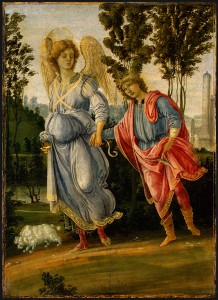The Representation of Movement

Filippino Lippi
Tobias and the Angel, c. 1475/80
Oil and tempera (?) on panel, 32.7 x 23.5 cm (12 7/8 x 9 1/4 in.)
National Gallery of Art, Washington, DC, Samuel H. Kress Collection
Image courtesy of the Board of Trustees, National Gallery of Art
1) Q: What do you see in this painting that conveys an impression of movement?
A: Movement is conveyed by some of the following features: the unstable poses of the figures and their tilting position on a downward slope (suggesting the pull of gravity resulting in forward momentum); the rippling drapery; the dog’s windswept fur; landscape elements such as the fall of light and shadow across the foreground; the shimmering foliage; and the streaks of clouds in the sky.
2) Q: What elements in the painting suggest the passage of time?
A: The view of the distant city and faraway hills alludes to a “before”—where the figures were before the moment in which we see them represented. The continuation of the path beyond the frame of the picture alludes to the “after” of their journey. The fish held by Tobias refers to both earlier and later episodes in the narrative.
3) Q: Why might a sense of movement have been important in this painting?
A: The story concerns a journey, a movement from one place to another.
4) Q: Why might painters in general have cultivated a sense of movement in their paintings?
A: Movement helped them to reproduce nature more convincingly, to add to the vitality and freshness of the imagery, and to enhance the immediacy of distant people and events.